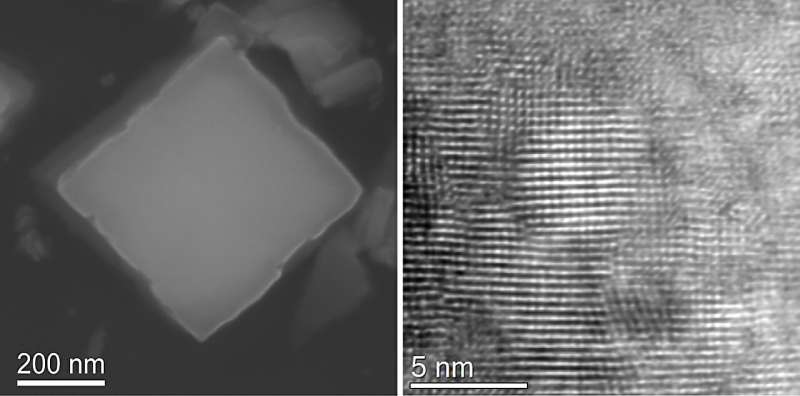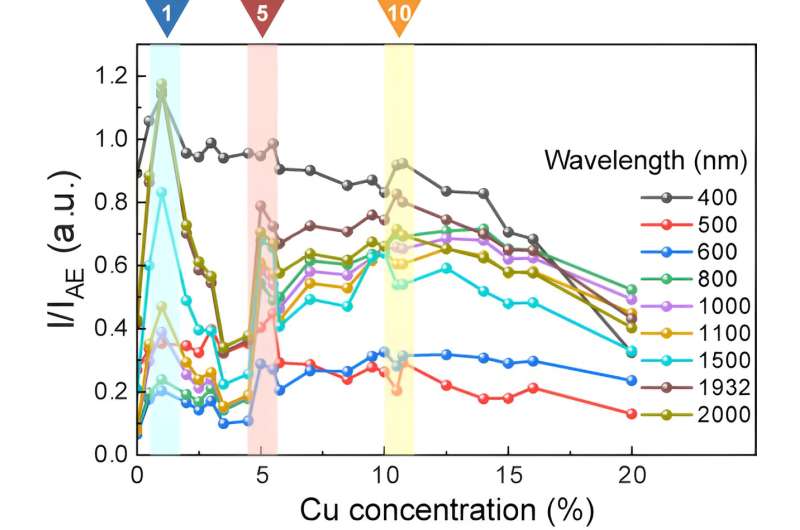Copper-infused nanocrystals boost infrared light conversion
19/09/2023
(Left) A single copper-doped tungstic acid nanocrystal; (right) Atomic resolution image of the nanocrystal. Credit: Melbert Jeem
Sunlight is an inexhaustible source of energy, and utilizing sunlight to generate electricity is one of the cornerstones of renewable energy. More than 40% of the sunlight that falls on Earth is in the infrared, visible and ultraviolet spectra; however, current solar technology utilizes primarily visible and ultraviolet rays. Technology to utilize the full spectrum of solar radiation—called all-solar utilization—is still in its infancy.
A team of researchers from Hokkaido University, led by Assistant Professor Melbert Jeem and Professor Seiichi Watanabe at the Faculty of Engineering, have synthesized tungstic acid–based materials doped with copper that exhibited all-solar utilization. Their findings are published in the journal Advanced Materials.
"Currently, the near- and mid-infrared spectra of solar radiation, ranging from 800 nm to 2500 nm, is not utilized for energy generation," explains Jeem. "Tungstic acid is a candidate for developing nanomaterials that can potentially utilize this spectrum, as it possesses a crystal structure with defects that absorb these wavelengths."
The team used a photo-fabrication technique they had previously developed, submerged photo-synthesis of crystallites, to synthesize tungstic acid nanocrystals doped with varying concentrations of copper. The structures and light-absorbing properties of these nanocrystals were analyzed; their photothermal, photo-assisted water evaporation, and photo-electrochemical characteristics were measured.

A summarized relative light absorption of the tungstic acid crystals ranging from ultraviolet to infrared light. 1, 5, and 10 are the copper concentrations resulting in opto-criticality of the nanocrystals. Credit: Advanced Materials (2023). DOI: 10.1002/adma.202305494
The copper-doped tungsten oxide nanocrystals absorb light across the spectrum, from ultraviolet through visible light to infrared; the amount of infrared light absorbed was greatest at 1% copper doping. 1% and 5% copper-doped nanocrystals exhibited the highest temperature elevation (photothermal characteristic); 1% copper doped crystals also exhibited the greatest water evaporation efficacy, at approximately 1.0 kg per m2 per hour. Structural analysis of the 1% copper-doped nanocrystals indicated that the copper ions may be distorting the crystal structure of tungsten oxide, leading to the observed characteristics when light is absorbed.
"Our discoveries mark a significant advance in advancement in the design of nanocrystallites capable of both synthesizing and harnessing all-solar energy," concludes Watanabe. "We have demonstrated that copper doping grants tungstic acid nanocrystal a variety of characteristics via all-solar utilization. This provides a framework for further research in the field as well as for the development of applications."
Source: https://tinyurl.com/4hecyfxc via Phys.Org

